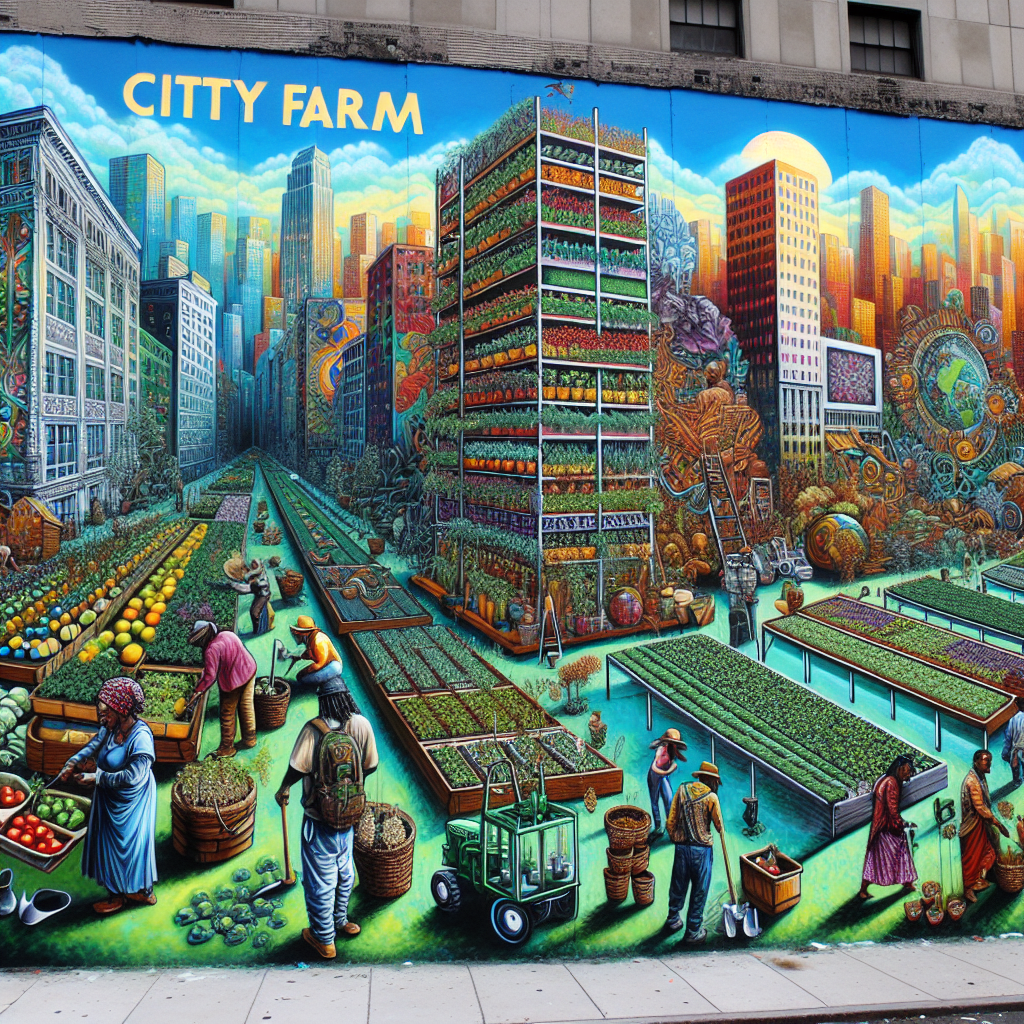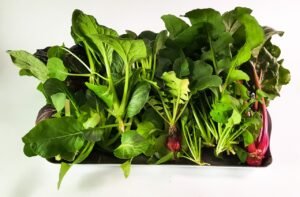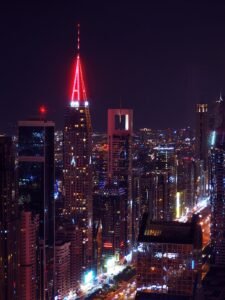
In this article, we will explore the fascinating intersection of art and sustainable urban farming practices. Discover how you, through the power of creativity and public installations, can inspire and educate communities about the importance of growing food locally. By examining innovative examples around the world, you will learn how art can serve as a catalyst for positive change, fostering healthier and more environmentally-conscious cities. Get ready to embark on a journey where art meets agriculture, and discover how you can be a part of this exciting movement.
Benefits of Sustainable Urban Farming
Reduced carbon footprint
Sustainable urban farming offers tremendous benefits for reducing carbon footprint in cities. By growing produce locally, there is no need for long-distance transportation and refrigeration. This means that fewer fossil fuels are used, resulting in lower greenhouse gas emissions. Furthermore, sustainable urban farming often incorporates practices such as composting and rainwater harvesting, which further reduce the environmental impact.
Increased access to fresh produce
One of the key benefits of sustainable urban farming is the increased accessibility to fresh produce. In many communities, especially in urban areas, finding fresh and affordable fruits and vegetables can be a challenge. By establishing urban farms within walking or biking distance of residents, fresh produce becomes readily available. This not only improves physical health but also encourages a more sustainable and healthy diet.
Improved local economy
Sustainable urban farming has the potential to boost the local economy in various ways. Firstly, it creates job opportunities, particularly in areas with high unemployment rates. By establishing urban farms and related businesses, such as farmers markets and cafes, more people can find employment and contribute to the local economy. Additionally, sustainable urban farming has the potential to attract tourism and stimulate local businesses, as visitors are drawn to the unique and vibrant atmosphere created by these urban agriculture initiatives.
Role of Art and Public Installations in Promoting Sustainable Urban Farming
Raising awareness
Art and public installations play a crucial role in raising awareness about sustainable urban farming practices. Visual displays can captivate the attention of passersby and communicate important messages about the benefits of urban farming. Whether it’s through murals, sculptures, or interactive installations, art has the power to spark conversations and draw attention to the importance of sustainable practices in an urban setting.
Educating communities
Art has the ability to educate communities about sustainable urban farming in a creative and engaging way. Public installations can showcase the different techniques and technologies used in urban farming, such as vertical gardens or hydroponics. By visually demonstrating these methods, art can help people understand the concept of urban farming and its potential for addressing food security and environmental concerns.
Creating a sense of community
Art and public installations have the unique ability to bring people together and create a sense of community. By incorporating artistic elements into urban farming spaces, such as community gardens or farmers markets, these spaces become more inviting and inclusive. Public installations can serve as gathering places for residents, fostering social interactions, and creating a shared sense of ownership and pride in the urban farming initiatives.
Integration of Art and Public Installations with Sustainable Urban Farming
Murals depicting urban farming
Murals depicting urban farming can transform the visual landscape of a city and engage the public in a meaningful way. These large-scale paintings can showcase the beauty and diversity of urban farming practices, while also conveying important messages about sustainability and food security. By incorporating murals into urban farming spaces, they become vibrant and inspiring places that draw attention to the benefits of these initiatives.
Sculptures incorporating sustainable farming techniques
Sculptures that incorporate sustainable farming techniques offer a unique and interactive way to showcase the connection between art and urban farming. For example, sculptures can be designed to collect rainwater or serve as vertical gardens, demonstrating the integration of art and agricultural practices. These sculptures not only serve as visual attractions but also as functional elements within the urban farming ecosystem.
Interactive art installations in urban gardens
Interactive art installations in urban gardens can create a dynamic and engaging experience for visitors. These installations can allow people to actively participate in the urban farming process, such as by testing soil quality or sowing seeds. By involving people in these interactive activities, art not only educates but also inspires individuals to take action and become involved in sustainable urban farming practices.
Collaboration between Artists and Urban Farmers
Sharing of knowledge and expertise
Collaboration between artists and urban farmers allows for the sharing of knowledge and expertise. Artists can learn about sustainable farming practices from farmers, gaining a deeper understanding of the technical aspects and challenges of urban agriculture. On the other hand, farmers can benefit from the creativity and artistic vision of artists, who can help bring their agricultural initiatives to life through visually appealing and impactful installations.
Co-creation of artworks inspired by urban farming
Artists and urban farmers can come together to co-create artworks inspired by urban farming. By combining their respective skills and experiences, they can develop unique and thought-provoking pieces that embody the spirit of sustainable urban farming. This collaborative approach not only produces amazing works of art but also strengthens the connection between art, farming, and the community.
Opportunities for cross-disciplinary projects
Collaboration between artists and urban farmers opens up opportunities for cross-disciplinary projects. For example, artists and farmers can work together to develop educational programs that combine artistic expression and agricultural knowledge. These programs can engage students and community members in hands-on activities that promote sustainable urban farming practices while fostering creativity and collaboration.
Engaging the Local Community
Involving residents in the creation of public artworks
Engaging the local community in the creation of public artworks is an effective way to build a sense of ownership and pride in urban farming initiatives. By involving residents in the design and creation process, they become emotionally invested in the artwork and the underlying message it represents. This involvement can be achieved through community workshops, where residents can contribute their ideas and even participate in the physical creation of the artwork.
Organizing workshops and art competitions
Workshops and art competitions offer opportunities for the local community to learn and engage with sustainable urban farming in a hands-on way. Workshops can provide training on various aspects of urban farming, such as composting or seed starting, while art competitions can invite people to submit their creative interpretations of urban farming. These activities not only foster creativity but also serve as platforms for knowledge sharing and community building.
Hosting farm-to-table events at urban farms
Hosting farm-to-table events at urban farms is an effective way to engage the local community and promote sustainable urban farming practices. These events can feature locally grown produce, prepared and served by local chefs. By showcasing the connection between urban farming and healthy, fresh food, these events help people understand the benefits of supporting local, sustainable agriculture. Additionally, farm-to-table events can create opportunities for farmers, artists, and community members to connect and collaborate.
Examples of Art and Public Installations Promoting Sustainable Urban Farming
Vertical gardens on building facades
Vertical gardens on building facades have become a popular form of art and public installations that promote sustainable urban farming. These installations not only beautify the urban landscape but also provide space for growing plants and vegetables in limited spaces. By utilizing building facades, vertical gardens maximize the use of available surfaces while promoting greenery in urban environments.
Mosaic pavement showcasing crop diversity
Mosaic pavements showcasing crop diversity are another creative way to promote sustainable urban farming through art. These intricate and colorful mosaics depict various fruits, vegetables, and grains, highlighting the importance of agricultural biodiversity. By incorporating these mosaics into public spaces or sidewalks, people are reminded of the importance of preserving crop diversity and supporting sustainable farming practices.
Scarecrow art installations in community gardens
Scarecrow art installations in community gardens serve a dual purpose of deterring pests and adding artistic elements to the garden landscape. These creatively designed scarecrows not only protect crops from birds and animals but also become focal points within the garden. By incorporating art into functional elements, such as scarecrows, the community garden becomes a visually appealing and engaging space that promotes sustainable urban farming.
Measuring the Impact
Surveys and interviews with community members
To measure the impact of art and public installations on promoting sustainable urban farming, surveys and interviews with community members can be conducted. These surveys can assess participants’ knowledge, attitudes, and behaviors related to sustainable farming practices before and after exposure to art installations. Interviews can provide more in-depth insights into individuals’ experiences and perceptions of urban farming, as influenced by the art they have encountered.
Monitoring changes in urban farming practices
Monitoring changes in urban farming practices is an important way to gauge the impact of art and public installations. By tracking the adoption of sustainable farming techniques, such as composting or rainwater harvesting, in urban farms with art installations versus those without, it is possible to assess whether the art has inspired changes in behavior and practices. This data can help measure the tangible effects of art in promoting sustainable urban farming.
Assessing public perception of sustainable urban farming
Assessing public perception of sustainable urban farming can provide insights into the effectiveness of art and public installations in promoting awareness and understanding. Surveys or focus groups can be conducted to gauge public perceptions of urban farming and its benefits before and after exposure to art installations. By capturing public opinions and attitudes, it becomes possible to determine whether art has effectively influenced perceptions of sustainable urban farming.
Challenges and Solutions
Limited funding for art projects
One of the challenges in promoting sustainable urban farming through art and public installations is the limited funding available for such projects. To overcome this challenge, partnerships can be formed with local businesses, philanthropic organizations, or government agencies that prioritize sustainability. Through these partnerships, funding can be secured to support the creation and maintenance of art installations that promote sustainable urban farming.
Engaging diverse communities
Engaging diverse communities is another challenge when promoting sustainable urban farming through art and public installations. To overcome this challenge, it is important to take into consideration the cultural backgrounds, languages, and interests of various community groups. Collaborations with local community organizations, cultural centers, or grassroots movements can help ensure that the art installations are inclusive and resonate with diverse audiences.
Balancing aesthetics with functionality
Balancing aesthetics with functionality is a challenge when integrating art and public installations with sustainable urban farming. While it is important for art installations to be visually appealing, they should also serve a practical purpose within the urban farming context. Engaging artists and urban farmers in collaborative design processes can help strike a balance between aesthetics and functionality, ensuring that the installations enhance the farming experience while capturing the imagination of the public.
Case Studies on Successful Projects
Brooklyn Grange Rooftop Farms in New York City
The Brooklyn Grange Rooftop Farms in New York City serve as an excellent case study of successfully integrating art and urban farming. This urban farming project has incorporated various artistic elements, including large-scale murals and sculptures, into their rooftop farms. These art installations not only beautify the urban landscape but also raise awareness about sustainable farming practices and inspire the local community to get involved in urban agriculture.
Urban Souls in Paris, France
Urban Souls in Paris, France, is another successful example of how art and public installations can promote sustainable urban farming. This project features interactive art installations in urban gardens that engage visitors in activities such as watering plants or harvesting vegetables. By involving people in these hands-on experiences, Urban Souls fosters a deeper connection between art, urban farming, and the local community, ultimately promoting sustainable practices and environmental consciousness.
The Philadelphia Mural Arts Program
The Philadelphia Mural Arts Program is a renowned initiative that has successfully used public murals to promote sustainable urban farming. This program has collaborated with local artists, farmers, and community members to create vibrant and impactful murals that celebrate the city’s agricultural heritage and encourage sustainable practices. By involving the community in the creation process, the Philadelphia Mural Arts Program has fostered a sense of ownership, pride, and engagement in sustainable urban farming.
Conclusion
The potential of art to promote sustainable urban farming is immense. Through art and public installations, awareness can be raised, communities can be educated, and a sense of community can be created. The integration of art and sustainable urban farming offers countless possibilities, from murals depicting urban farming to interactive installations in urban gardens. Collaborations between artists and urban farmers can lead to the sharing of knowledge and expertise, as well as the co-creation of inspiring artworks. Engaging the local community through involvement in public artworks, workshops, and farm-to-table events further strengthens the impact of these initiatives. By measuring the impact, addressing challenges, and studying successful case studies, it becomes clear that art and public installations have the power to transform urban landscapes, promote sustainable practices, and create a greener and more vibrant future.







